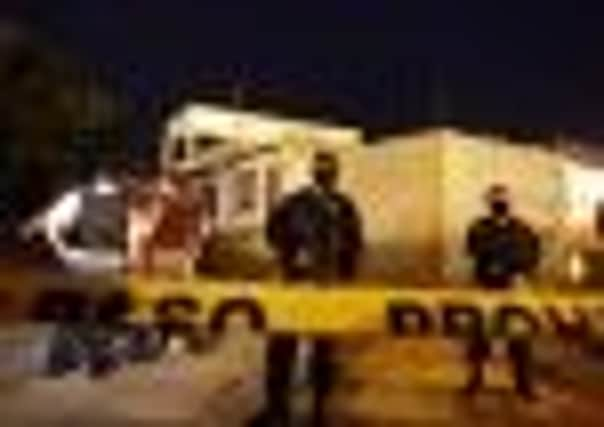Book review: El Narco


At a conservative estimate there have been 35,000 murders in Mexico in the last six years, all of them tied into a drug cartel war that has seemingly reached catastrophic proportions.
In El Narco, his brilliant account of the drug trade in Mexico, Ioan Grillo, an English journalist who has been based in Latin America for the last ten years, does a fantastic job of defining, explaining and analysing the current problems in the country. It is a wonderful piece of quality, in-depth journalism, Grillo’s writing is lucid and perceptive, passionate but balanced, and he really seems to get under the skin of the terrible situation.
Advertisement
Hide AdAdvertisement
Hide AdMixing real investigative reporting with eyewitness accounts, interviews with major players in the conflict and statistical analysis, Grillo has used his decade’s worth of experience in the region to delve deeply into the history, anatomy and possible future of what is, frankly, a jaw-dropping situation.
El Narco is a truly shocking read and it’s also quite often profoundly depressing on the depths to which humanity can sink. The situation at the moment is one in which rival drug smuggling cartels battle each other and the Mexican and American authorities on a daily basis, in what started out as a simple turf war, but which has quickly turned into something akin to a civil war, and a depraved and vicious one at that.
The drug cartels are now effectively paramilitary organisations, with armies of thousands of well-trained soldiers, assassination squads, kidnapping gangs and much more. These are organisations whose billions of dollars of drug smuggling profits have given them such power that they regularly execute leading politicians, federal police and rival gang members by the dozen. Running gun battles in the streets, audacious prison breaks and brazen and brutal massacres in broad daylight are commonplace.
The scale of the whole situation beggars belief. On the smuggling side of things, thousands of tons of marijuana, cocaine, heroin and most recently crystal meth are shipped across the border to the US every year, an expansive business that nets in at least 30 billion dollars per annum for the cartels.
It turns out that 30 billion dollars can buy you a lot of AK-47s, rocket-propelled grenade launchers and car bombs. What it can also buy you is protection from police. Most local police forces and politicians in regions of northern Mexico are in the pocket of one drug cartel or another, with the result that there are frequently running street battles between different police forces.
Although there is no political or religious ideology behind any of this, Grillo argues well that this is, in effect, an insurgency, a situation that threatens the very fabric of society in Mexico, and one that, if not stopped, could result in an apocalyptic descent into chaos across the nation and even spill across its borders into other Latin American states and the US.
After a shocking opening interview with a convicted serial killer who can’t remember and doesn’t care how many people he’s killed, El Narco takes a step back in perspective to look at how this situation came about historically.
Advertisement
Hide AdAdvertisement
Hide AdIn the 1970s a small drug smuggling network became established, dealing mainly with heroin and marijuana. Large expanses of suitably remote countryside made the growing of both of these easy, and a huge land border with America, where both were highly desirable, led to an inevitable surge in production and shipping.
But it wasn’t until the 1980s and Reagan’s war on drugs that things really took off. Reagan’s administration concentrated on cocaine coming out of Columbia, with the result that cocaine began travelling through Mexico rather than across the Gulf of Mexico to Florida. Gradually the Mexicans muscled in on Columbia’s territory, and a willingness to go that extra mile, to be that little bit more ruthless for whatever reason, saw them take a firm grip across the whole region.
And drug running these days is only a small part of it. Protection rackets, kidnappings and extortion are all part of everyday life for ordinary Mexicans now, and the state seems powerless to prevent it.
Little wonder, when the drug cartels’ huge wealth can buy anything.
Along with corrupt police and officials, it’s estimated that 100,000 soldiers have deserted from the Mexican army in the last ten years to join paramilitary drug cartels. Young kids basically get the state to train them into killers, then defect for a better wage. In the face of that, it’s hard to imagine a solution.
To Grillo’s credit, he tries to conjure up one. Part III of El Narco is called Destiny, and looks at possible ways forward. Among the ideas floated are better gun control in America (where all the hardware comes from for the cartels), better education, proper funding for the Mexican military and police, and even the controversial idea of drug legalisation in the US.
What’s clear from El Narco is that something has to be done, and soon.
Advertisement
Hide AdAdvertisement
Hide AdIn a country where disenfranchised teenagers will kill an unknown person for just $85 and the kudos, where decapitated heads of rivals are put on display in town squares, where whole police stations and prisons are shot to pieces, the fear of complete anarchy is rife.
Because of Grillo’s tireless work and clear-eyed reportage, the world now knows much more about the terrible situation in Mexico and how it came about. If only there was as much clarity concerning the country’s worrying future.
• El Narco
by Ioan Grillo, Bloomsbury, 336pp, £12.99